The Scottish Health Survey 2021 - volume 1: main report
Presents results for the Scottish Health Survey 2021, providing information on the health and factors relating to health of people living in Scotland.
Chapter 4 Diet and Food Insecurity
Chapter Summary
In 2021, the proportion of adults who consumed 5 or more portions of fruit and vegetables per day was the same as in 2019 and fairly stable since 2003.1

Fruit and vegetable consumption (mean number of portions per day) was lowest for those aged 16-24 and highest for those aged 65-74.
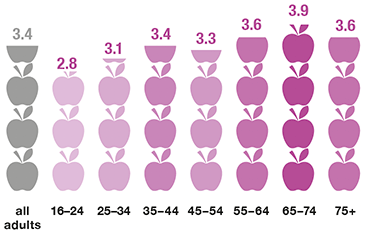
In 2021, the proportion of children aged 2-15 who consumed 5 or more portions of fruit and vegetables and the average daily consumption was significantly higher than in any of the years 2008 to 20192.
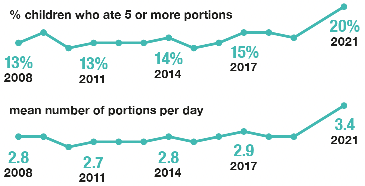
In 2021, the average energy intake per person per day was significantly higher for men than for women.
- 1,632 kcal/day - all adults
- 1,786 kcal/day - men
- 1,495 kcal//day - women
Energy intake (kcal/day) varied by age; highest for those aged 35-44 and lowest for those aged 65 and above.

In 2021, one in five adults met the energy density3 Scottish Dietary Goal (SDG) of no more than 125 kcal/100g/day, with women more likely to do so than men.
- 20% of adults
- 16% of men
- 24% of women
In 2021, almost half of all adults met the SDG for total fat intake,4 while only a quarter met the SDG for saturated fat intake.5
- 48% Total fat intake
- 26% Saturated fat intake
In 2021, just over a fifth of adults met the SDG for free sugars intake6, with adults aged 55-74 being the most likely to do so.
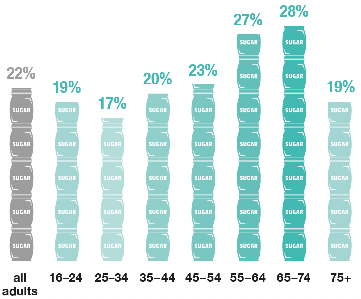
Nearly three quarters of adults in 2021 consumed no more than 70g of red and red processed meat per day. Women were more likely than men to consume no more than 70g per day.
- 72% All adults
- 64% Men
- 79% Women
In 2021, a very low proportion of adults met the SDG for fibre intake,7 with men being more likely than women to do so.
- 6% All adults
- 8% Men
- 5% Women
Across all adults in 2021, a lack of money or other resources in the previous 12 months resulted in:
- 9% worried about running out of food
- 6% ate less
- 3% ran out of food
In 2021, younger adults were more likely to be worried that they would run out of food.
- 14% 16–44
- 8% 45–64
- 1% 65+
In 2019/2021 combined, the highest levels of food insecurity were among single parents and single adults under the age of 65.
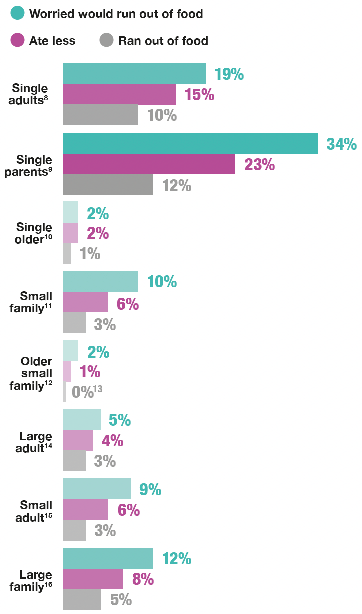
1 Figures for 2021 have been calculated from data collected as part of the Intake24 dietary recalls. Data from earlier years was taken from the Scottish Health Survey fruit and vegetable module.
2 The changes from face-to-face (in previous years) to telephone interviewing (in 2021) may have affected the time series.
3 Energy density of food is generally higher for foods rich in fat and sugar, and lower for starchy carbohydrates, fruits and vegetables.
4 The SDG is for average intake of total fat to reduce to no more than 35% of food energy. Food energy does not include energy from alcohol.
5 The SDG is for average intake of saturated fat to reduce to no more than 11% of food energy. Food energy does not include energy from alcohol.
6 The SDG is that average intake of free sugars does not exceed 5% of total energy. Total energy includes energy from alcohol.
7 The SDG is for an increase in average consumption of AOAC (Association of Analytical Chemists) fibre to 30g/day.
8 One adult aged 16-64, no children.
9 One adult any age and one or more children. It should be noted that the definition of a single parent does not make any distinction between situations where a child has regular contact and/or partly resides with their other parent and a child who solely resides with and is cared for by one parent.
10 One adult aged 65 and over, no children.
11 Two adults of any age and one or two children.
12 One adult under 65 and one adult 65 and over or two adults 65 and over, no children.
13 0 non-zero values of less than 0.5% and thus rounded to zero.
14 Three or more adults, no children.
15 Two adults under 65, no children.
16 Two adults of any age and three or more children or three or more adults and one or more children.
Diet and Food Insecurity
Stephen Hinchliffe
4.1 Introduction
Poor diet is a leading risk factor for ill health internationally[1] and has been linked to a range of comorbidities including diabetes, cardiovascular disease, hypertension and certain cancers.[2],[3] The risk of such conditions can be reduced by improvements in the nutritional content of diets (increasing fibre, fruit and vegetable intake,[4] decreasing salt, fats and sugar)[5] and overall reductions in elevated body mass.[6]
Evidence is suggestive of varying impacts of the pandemic on diet and physical activity, with both positive and less beneficial behaviour adopted by individuals in response to their own and national circumstances, sometimes interchangeably.[7] Several reports have also highlighted the negative impact on food insecurity and the widening of existing inequalities with an 89% increase in demand for emergency food parcels in the UK in April 2020 compared with the same period in 2019 and foodbank demand more than doubling during the same period.[8]
4.1.1 Policy background
Diet
Eating well, maintaining a healthy weight and regular physical exercise are key public health priorities for Scotland. A Healthier Future: Scotland's Diet and Healthy Weight Delivery Plan,[9] published in July 2018, sets out a wide range of actions that support people to eat well and maintain a healthy weight, while reducing diet-related inequalities.
The Scottish Dietary Goals (SDGs), revised in 2016,[10] provide the basis for a healthy balanced diet.The Goals decribe, in nutritional terms, a diet that will improve and support the health of the Scottish populationincluding:
- A reduction in calorie intake by 120 kcal per person per day, and average energy density of the diet to be lowered to 125kcal/100g by reducing intake of high fat and/or sugary products and by replacing with starchy carbohydrates (e.g. bread, pasta, rice and potatoes), fruits and vegetables.
- Average intake of a variety of fruit and vegetables to reach at least five portions per person per day (>400g per day).
- Oil rich fish consumption to increase to one portion (140g) per person per week.
- Average intake of red and red processed meat to be limited to around 70g per person per day. Average intake of the highest consumers of red and processed meat (90g per person per day) not to increase.
- Average intake of total fat to reduce to no more than 35% of food energy, average intake of saturated fat to reduce to no more than 11% of food energy and average intake of trans fatty acids to remain below 1% of food energy.
- Average intake of free sugars not to exceed 5% of total dietary energy.
- Average intake of salt to reduce to 6g per day for adults.
- An increase in average intake of dietary fibre to 30g per person per day for adults.
- Total carbohydrate to be maintained at an average population intake of approximately 50% of total dietary energy with no more than 5% from free sugars.
Food insecurity
The Scottish Government has committed to publishing a plan on ending the need for food banks. A consultation on a draft plan earlier this year set out a human rights approach to the issue of food insecurity which prioritises action to prevent poverty and promotes cash-first responses to hardship so that people are able to make choices that suit their needs and preferences. A final version of the plan will be published in the Autumn. The Scottish Government has allocated almost £3 billion to a range of supports this year that will contribute to mitigating the impact of the increased cost of living on households.
4.1.2 Reporting on diet and food insecurity in the Scottish Health Survey (SHeS)
This chapter presents findings on the reported dietary intakes of adults in the Scottish population in 2021, in relation to some of the SDGs. Reporting includes average daily intakes of:[11]
- Fruit and vegetables (portions)
- Energy (kcal) and energy density (kcal/100g)
- Total fat and saturated fat (g and % food energy)
- Free sugars (g and % total energy)
- Red and red processed meat (g)
- Fibre (g)
The proportion meeting each of these SDGs, with the exception of the SDG for reduction in energy intake, is also reported. The chapter also presents findings on children's fruit and vegetable consumption and reported food insecurity.
In 2021, dietary information for adults was collected using online dietary recalls (Intake24) (two recalls for each adult), following the conclusion of the main SHeS interview. The use of Intake24 allowed for monitoring of a number of the Scottish Dietary Goals. It also allowed for more comprehensive calculations of fruit and vegetable consumption than in previous years, as, for example, fractions of a portion within meat dishes or soups were counted in 2021, when this was not always the case before. As a consequence of this change, there may have been some disruption to the time series, particularly around the counting of those who had consumed no fruit and vegetables.
For detailed definitions of terminology used in this chapter and for further details on the data collection methods for diet and food insecurity, please refer to Chapter 2 of the Scottish Health Survey 2021- volume 2: technical report.
Supplementary tables on diet and food insecurity are also published on the Scottish Government website: Scottish Health Survey.
4.2 Diet and Food Insecurity
4.2.1 Adult fruit and vegetable consumption, 2003 to 2021, by sex
In 2021, just over one-in-five adults (22% - 22% of men and 23% of women) consumed the recommended five or more portions of fruit and vegetables per day,[12] the same as in 2019. This figure has remained fairly stable since 2003 (21%). The change in the proportion recorded as consuming no fruit or vegetables, from 10% in 2019 to 5% in 2021 could be impacted by the inclusion of vegetables and fruit from composite dishes in 2021.
On average, adults consumed 3.4 portions of fruit and vegetables per day, similar to the portions consumed in 2019 (3.3). The mean portions of fruit and vegetables for men (3.3) and women (3.5) were not significantly different. Table 4.1
4.2.2 Adult fruit and vegetable consumption, 2021, by age and sex
In 2021, younger adults, and young men in particular, were less likely than others to consume the recommended five portions of fruit and vegetables per day. Of adults aged 16-24, 13% met the SDG, including 9% of men and 17% of women. This proportion was highest for those aged 65-74, where 29% consumed their five-a-day (28% of men and 29% of women).
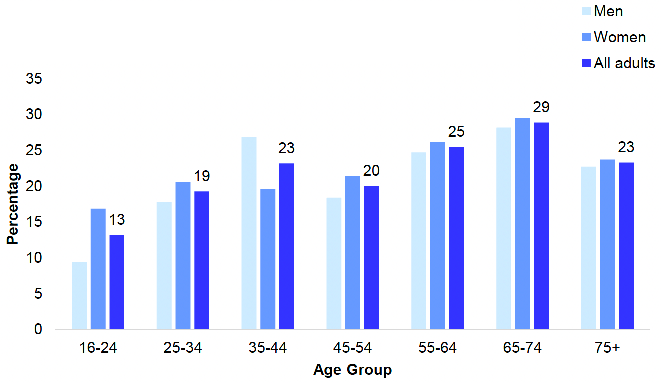
Mean consumption followed this same pattern, with the lowest number of fruit and vegetables on average for those aged 16-24 (2.8 portions, 2.5 for men and 3.1 for women), and the highest for those aged 65-74 (3.9 portions, 3.7 for men and 4.0 for women). Figure 4A, Table 4.2
4.2.3 Child fruit and vegetable consumption, 2008 to 2021, by sex
In 2021, dietary information for children was collected using the same questions as in previous years. However, changes from face-to-face to telephone interviewing may still have affected the time series.
In 2021, the proportion of children aged 2-15 who consumed five portions or more of fruit and vegetables in a day was 20%, significantly higher than in any of the years 2008 to 2019, when it stayed fairly constant at between 12% and 15%. Boys and girls were both likely to have met the SDG in 2021 (20% of boys and 21% of girls).
The proportion who consumed no fruit and vegetables in the previous day was also significantly lower in 2021 (5%) than in 2019 (9%), and in all years since 2008 with the exception of 2015 (7%). Again, there was no significant difference in 2021 between boys (6%) and girls (5%).
Similarly, the mean number of portions consumed per day by children aged 2-15 was higher in 2021 (3.4) than in any of the years 2008 to 2019 (2.6 to 2.9). This was the same for boys and girls in 2021 (3.4). Table 4.3
4.2.4 Child fruit and vegetable consumption, 2021, by age and sex
In 2021, there were no significant variations recorded in those eating some fruit and vegetables by age or sex among children aged 2-15. Mean consumption was between 3.2 and 3.5 portions for all age groups. The proportion meeting the five-a-day SDG was between 15% and 24% in each of the age groups (15% for children aged 11-12 and 24% for those aged 8-10). Table 4.4
4.2.5 Adult average energy intake per day and average energy density per day, 2021, by age and sex
In 2021, average energy intake per person per day was 1,632 kcal, significantly higher for men (1,786 kcal/day) than for women (1,495 kcal/day). It should be noted that, on average, men require more calories than women.
Energy intake varied by age, being highest among those aged 35-44 (1,772 kcal/day) and lowest for those aged 65 and above (1,548-1,558 kcal/day).
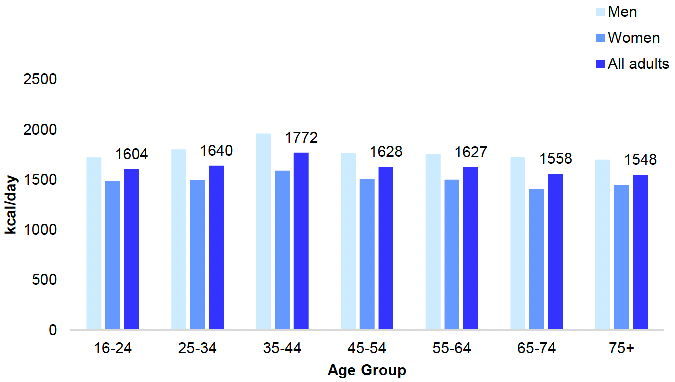
Energy density of food is generally higher for foods rich in fat and sugar, and lower for starchy carbohydrates, fruits and vegetables. The average energy density of foods (including milk) consumed by adults in 2021 was 160 kcal/100g/day.[13]
In every age group, for both men and women, average energy density exceeded the SDG of 125 kcal/100g/day. Average energy density was higher for men (165 kcal/100g/day) than for women (156 kcal/100g/day). It was also higher for younger than older adults (170-172 kcal/100g/day for those aged 16-44, compared with 145 kcal/100g/day for those aged 65 and above). One-in-five adults (20%) met the energy density goal, with women more likely to do so than men (24% and 16% respectively). Older adults were also more likely to meet the goal (29% - 31% for those aged 65 and above, compared with 8% for those aged 16-24). Figures 4B, 4C and 4D, Table 4.5
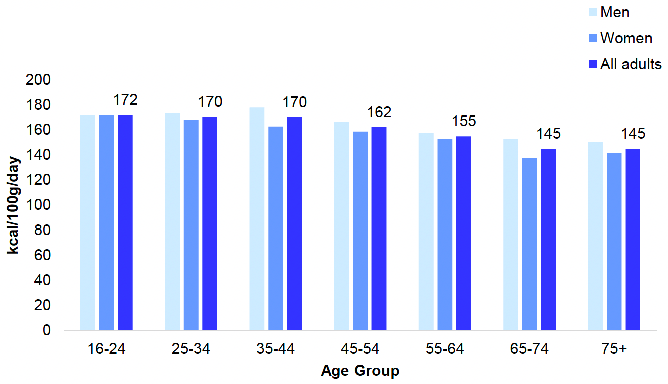
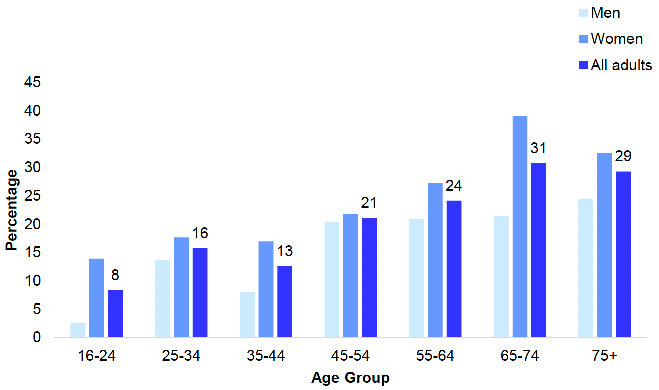
4.2.6 Adult total fat/saturated fat intake, 2021, by age and sex
Almost half of all adults (48%) met the SDG for total fat of no more than 35% of food energy, with men and women equally likely to achieve this goal (47% and 49% respectively). The proportion of food energy from total fat was an average of 34% (34% for men and 35% for women).
Adults were less likely to meet the SDG for saturated fat of no more than 11% of food energy; 26% of adults met this goal (27% of men and 26% of women). On average, adults derived 13% of their food energy from saturated fat (13% for both men and women).
The average proportion of food energy from total fat, and the proportion of adults meeting the SDG for total fat did not vary significantly by age. The equivalent figures for saturated fat did, however, vary by age. Those aged 25-34 were most likely to meet the SDG for saturated fat (33%) and had the smallest average proportion of food energy derived from saturated fat (12%). The opposite was true for those aged 75 and above, with 18% meeting the SDG and an average of 14% of food energy from saturated fat.
In 2021, adults consumed 63.0g of total fat per day on average, of which 24.1g was saturated fat. Men, who consume more calories overall, consumed higher quantities of both fat (68.4g) and saturated fat (26.0g) on average than women (58.2g and 22.4g respectively).
The average amount of total and saturated fat in the diet varied by age, with the highest amounts among those aged 35-44 (69.4g/day and 26.3 g/day respectively). By comparison mean total fat consumption was 58.7g for those aged 75 and above, and between 61.0g and 63.6g for the other age groups. Saturated fat consumption in the diet was 22.7g to 24.1g for the other age groups (16-34 and 45 and over). Figure 4E, Table 4.6
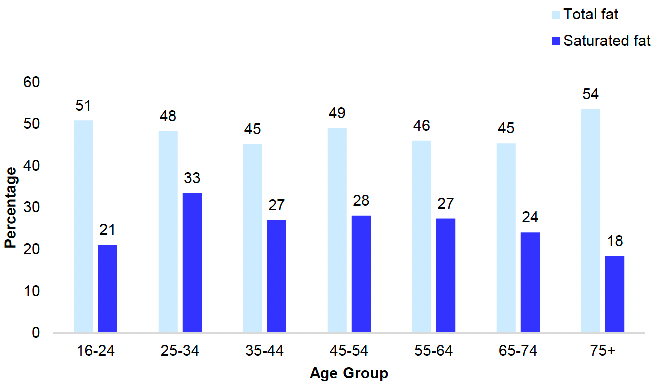
4.2.7 Adult free sugars intake, 2021, by age and sex
The SDGs recommend that free sugars account for no more than 5% of total dietary energy. Just over a fifth (22%) of adults met the SDG (same for both men and women).
The proportion of total energy derived from free sugars was well above 5% for all age groups, for both men and women. On average, adults derived 10% of their total energy from free sugars. The average proportion of total energy derived from free sugars was the same for both men and women (10%).
There were differences in free sugar consumption by age. Those aged 55-74 had the highest proportion meeting the SDG (27% - 28%) and the lowest average proportion of total energy that is from free sugars (8%).
In 2021, adults consumed 43.0g of free sugars per day on average. Men, who typically consume more calories than women, consumed more free sugars (a mean of 46.8g/day, compared with 39.7g/day). Those aged 55-74 had the lowest mean for free sugar intake (35.7 - 37.8g/day). Figure 4F, Table 4.7
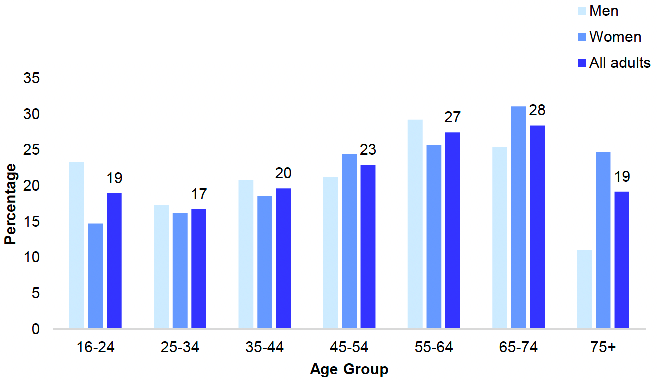
4.2.8 Adult red meat and red processed meat intake, 2021, by age and sex
The SDG is that average intakes of red and red processed meat is pegged at around 70g per person per day, and that average intakes of the highest consumers of red and processed meat (90g per person per day) do not increase.
Nearly three quarters (72%) of adults (both consumers and non-consumers) consumed no more than 70g of red and red processed meat per day. A further 10% consumed over 70g/day but no more than 90g/day, while 18% consumed more than 90g/day. Men were less likely than women to consume no more than 70g/day (64%) and more likely to exceed 90g/day (25%), compared with 79% and 12% of women.
The quantity of red and red processed meat consumed did not vary significantly by age, and there was only a small amount of variation in the proportion meeting the SDG of no more than 70g/day, with this being highest for those aged 65 and above (76% - 77%) and lowest for those aged 35-44 (66%).
Among red and red processed meat consumers only,[14] 63% consumed no more than 70g per day, while 24% consumed more than 90g/day. Patterns by age were similar to those observed for all adults, with those aged 65 and above most likely to meet the SDG (69% - 70%).
On average, adults consumed 48.7g/day of red and red processed meat per day (59.5g/day for men, and 39.2g/day for women). Among red and red processed meat consumers only,[15] the average intake of red and red processed meat was 65.0g per day (75.6g for men and 54.6g for women). Table 4.8
4.2.9 Adult fibre intake, 2021, by age and sex
The SDGs recommend that adults consume 30g of fibre per day. In 2021, only 6% of adults met the goal. Men, who typically have a higher total food intake, were more likely to achieve the SDG (8% compared with 5%), whereas fibre intake did not vary significantly by age.
On average, adults consumed 17.2g of fibre per day, with men having a higher average consumption than women (18.0g/day and 16.6g/day respectively). Table 4.9
4.2.10 Adult food insecurity, 2017 to 2021, by age and sex
Levels of food insecurity have not changed significantly between 2017 and 2021. In 2021, 9% of adults were, at some time in the previous 12 months, worried that they would run out of food because of a lack of money or other resources. Equivalent figures for 2017 to 2019 were between 8% and 9%. In 2021, 6% reported that they had eaten less for this reason (6% - 7% in 2017 to 2019); and 3% ran out of food because of a lack of resources (3% - 4% in 2017 to 2019).
There was no significant difference between men and women in 2021 on any of these measures of food insecurity. There were, however, differences by age. Younger adults were more likely to be worried they would run out of food: 14% of those aged 16-44, compared with 8% of those aged 45-64 and 1% of those aged 65 and above. Older adults were less likely to say they had eaten less or had actually run out of food: 1% of those aged 65 and above had eaten less because of a lack of resources, compared with 9% of those aged 16-44 and 7% of those aged 45-64; and less than 0.5% had actually run out of food because of a lack of resources, compared with 4% of those aged 16-64. Table 4.10
4.2.11 Adult food insecurity, 2019/2021 combined, by household type and sex
There were some very noticeable differences in levels of food insecurity by household type in 2019/2021 combined. The highest levels of food insecurity were among single parents: 34% were worried that they might run out of food because of a lack of resources at some point in the previous 12 months, while 23% had eaten less than they otherwise would, and 12% had run out of food. Single adults under the age of 65 also had high levels of food insecurity, with 19% having worried that they would run out of food, 15% eating less and 10% running out of food in the previous 12 months. Families and other adult households with no one over the age of 64 had levels of food insecurity closer to the average, while older households were less likely to report having experienced food insecurity.
In 2019/2021 combined, 23% of men under the age of 65 living alone were worried they might run out of food, while 18% had eaten less and 12% had run out of food because of a lack of resources in the previous 12 months. These figures were all significantly higher than the respective ones for women under the age of 65 living alone (16%, 12% and 7% respectively). Figure 4G, Table 4.11
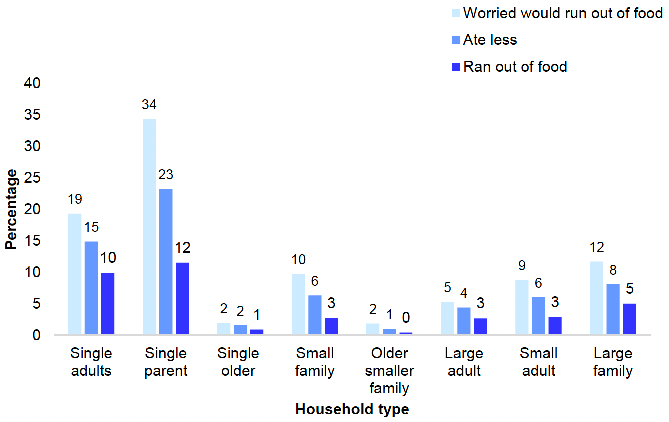
Table List
Table 4.1 Adult fruit and vegetable consumption, 2003 to 2021, by sex
Table 4.2 Adult fruit and vegetable consumption, 2021, by age and sex
Table 4.3 Child fruit and vegetable consumption, 2008 to 2021, by sex
Table 4.4 Child fruit and vegetable consumption, 2021, by age and sex
Table 4.5 Adult average energy intake per day and average energy density per day, 2021, by age and sex
Table 4.6 Adult total fat/saturated fat intake, 2021, by age and sex
Table 4.7 Adult free sugars intake, 2021, by age and sex
Table 4.8 Adult red and red processed meat intake, 2021, by age and sex
Table 4.9 Adult fibre intake, 2021, by age and sex
Table 4.10 Adult food insecurity, 2017 to 2021, by age and sex
Table 4.11 Adult food insecurity, 2019/2021 combined, by household type and sex
The tables can be found on the main report page under supporting files.
References and notes
1. Editorial (2017). Life, Death and Disability in 2016. The Lancet; 390(10100): p1083-1464.
2. Defined in adults as a body mass index (BMI) of 30 kg/m² or greater.
3. Abdelaal M, le Roux, C and Docherty, N (2017). Morbidity and mortality associated with obesity. Annals of Translational Medicine; 5(7): 101: p.1.
4. World Cancer Research Fund/American Institute for Cancer Research (2018). Diet, nutrition, physical activity and cancer: a global perspective. Continuous Update Project Expert Report. Food, Nutrition and Physical Activity and the Prevention of Cancer: a Global Perspective. [Online]
5. Food Standards Scotland. (2020). The Scottish Diet: It needs to change 2020 update.
6. World Cancer Research Fund/American Institute for Cancer Research (2018). Diet, nutrition, physical activity and cancer: a global perspective. Continuous Update Project Expert Report. Food, Nutrition and Physical Activity and the Prevention of Cancer: a Global Perspective.
7. Ingram, J, Maciejewski, G and Hand, C. (2020). Changes in Diet, Sleep, and Physical Activity Are Associated With Differences in Negative Mood During COVID-19 Lockdown. Frontiers in Psychology.
8. University of Glasgow: Policy Scotland (2020). Evidence round-up: Issues in recovery, food insecurity and learning loss.
9. A Healthier Future: Scotland's Diet & Healthy Weight Delivery Plan, Edinburgh: Scottish Government, 2018.
10. Revised Dietary Goals for Scotland, Edinburgh: Scottish Government, 2016.
11. Reporting will not include oily fish as the SDG is per week, salt as urinary sodium surveys are a more appropriate method to assess salt intakes, and trans fatty acids and total carbohydrate as the number of SDGs that could be reported on were limited.
12. An average of at least five portions on two days, calculated from the Intake24 food diaries. In previous years, participants were only asked about their consumption on the day prior to the interview.
13. For the energy density calculations used, see appendix four in D19-01_Final_Draft_Report_2001-2015_-_Following_Peer_Review_150818.pdf (foodstandards.gov.scot).
14. For the purposes of the analysis, red meat consumers are defined as those who consumed an average of more than 1g of red meat per day over the two days of the Intake24 dietary recalls.
15. For the purposes of the analysis, red meat consumers are defined as those who consumed an average of more than 1g of red meat per day over the two days of the Intake24 dietary recalls.
Contact
There is a problem
Thanks for your feedback